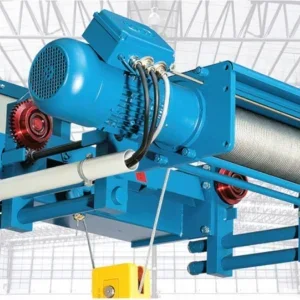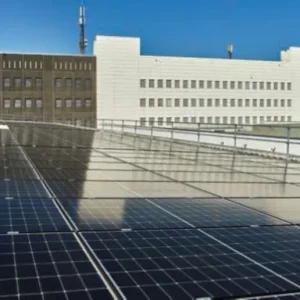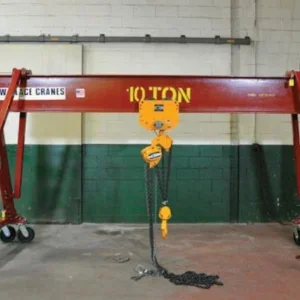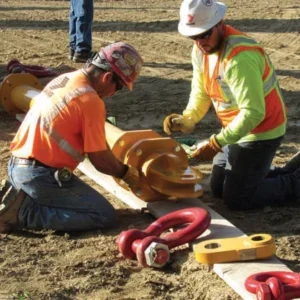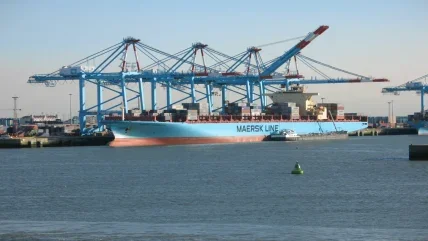
The Port of Antwerp-Bruges says it has made good progress in its first year of unification, with new investments and projects planned to further enhance its positioning in Western Europe’s maritime landscape.
The City of Antwerp and the City of Bruges finalised their agreement to merge their respective ports last year. As a result, the ports will be able to strengthen their position within the global supply chain and continue their course towards sustainable growth. The unified Port of Antwerp-Bruges will also be more resilient to the challenges of the future and will take a lead in the transition towards a low-carbon economy.
The merged port will become the most important container port (157 million tons/ year), one of the largest break bulk ports and the largest port for the throughput of vehicles in Europe. It will account for more than 15% of Europe’s liquid natural gas transited and will remain Europe’s most important chemical hub as well as being the largest port for cruise ships in the Benelux.
“We are proud of this historic agreement, which seals a long-awaited unification. By joining forces, we are on the way to becoming Europe’s global port, while at the same time reinforcing our position as the most important container port in terms of tonnage, a solid ro-ro [roll-on/roll-off] port and one of the largest break bulk ports in Europe,” says Annick De Ridder, port alderman and chair of the board of directors of the Antwerp Port Authority.
“This will make us even more attractive to our existing customers, to new investors and to all other potential stakeholders, and we will undisputedly be the main driver of [the regional] Flanders’ economy. Our ambition to bring the two ports together is about much more than simply tonnage and TEUs [twenty-foot equivalent units], however; it will enable us to focus even more firmly on the transition towards a low-carbon economy and to continue our efforts regarding the digitalisation of the supply chain. The ports of Zeebrugge [or Bruges] and Antwerp are to a large extent complementary and working together will make us more resilient to external challenges.”
The aim of the unification is to become the world’s first port that reconciles economy, people and climate and creating added value for the surrounding areas of Antwerp and Zeebrugge. As part of a joint plan, the two ports have defined three strategic priorities: sustainable growth, resilience and leadership in the energy and digital transition.
Port of Antwerp-Bruges will combine the best of both worlds and will focus on the strengths of each site. As De Ridder says, the ports of Antwerp and Zeebrugge are largely complementary. For example, Antwerp specialises in the handling and storage of containers, breakbulk and chemical products, while Zeebrugge is a major port for ro-ro traffic, container handling and the transhipment of liquid natural gas. Working more closely together will make it possible to consolidate sustainable growth, not only of each port’s individual market share, but also of the joint market share of both together.
To maximise the added value of a unification, the Port of Antwerp-Bruges will seek to develop and make optimum use of the interconnectivity between the two ports. The transportation of goods by rail between the sites will be bundled, estuary traffic (by inland vessels on the North Sea) will be optimised, and pipeline connections will also be on the list of priorities.
Committed strategic investments, such as the new sea lock in Zeebrugge and the additional container capacity in Antwerp, will go ahead. Future investments will be evaluated from a unified operational perspective, so that both ports will benefit.
The unified port will be able to respond more rapidly and effectively to social and technological developments, such as energy transition, innovation and digitalisation, too.
Sustainability already formed a central part of the strategic direction in Antwerp and in Zeebrugge, but the Port of Antwerp-Bruges will set the bar higher. Combining the industrial cluster in Antwerp and Zeebrugge’s location on the coast will create a unique opportunity to address the future energy challenges in Flanders and the wider region.
As such, the Port of Antwerp-Bruges will take up a leading position as an import hub for green hydrogen and will play an active and pioneering role in the hydrogen economy. In addition, the port, in collaboration with its industrial and maritime customers, will continue its efforts to reduce its carbon footprint and will examine methods of applying CCUS (carbon capture, utilisation and storage) in order to contribute to the transition towards a low-carbon port.
“Zeebrugge is the world’s largest automotive hub, a leading ro-ro port and an experienced, state-of-the-art natural gas hub. By combining our own strengths with the qualities offered by Antwerp, we will be able to do more and do it better. We will achieve this in the interests of and in consideration of our shared port operations, our city and our region. We will strengthen our joint economic and international position, while simultaneously creating added value for society in general,” says Dirk De fauw, mayor of Bruges and chair of Zeebrugge Port Authority.
BULK CARRIERS
In other news, AD Ports Group has announced plans to expand its fleet with the purchase of five bulk carriers and three crude oil tankers.
The acquisition will follow the recently signed agreements as part of the group’s strategic global expansion plan to enhance the shipping division under AD Ports Group’s Maritime Cluster (which includes Safeen Group – read on for more – Abu Dhabi Maritime Academy, providing education and training, and Abu Dhabi Maritime, the custodian and regulator of Abu Dhabi’s waterways).
The five bulk carriers, to be purchased for Dh459m, form part of the long-term agreement with Saif Powertec, signed in April 2022, for the movement of general cargo and dry bulk cargo between Fujairah Port in the UAE and Bangladesh, the Indian subcontinent, Southeast Asia and other global destinations.
The purchase of three crude oil tankers, with a total transaction value of Dh496m, will form part of the sevenyear vessel pooling agreement formed in December 2022 with KazMorTransFlot (KMTF), a subsidiary of Kazakh National Oil Company (KazMunayGas), for the transport of crude oil internationally.
“AD Ports Group consistently seeks opportunities to contribute to the development of comprehensive solutions for customers and partners in the energy and maritime sectors,” says Capt. Mohamed Juma Al Shamisi, MD and group CEO, AD Ports Group.
“The extension of our fleet with the purchase of another five bulk carriers and addition of an initial three crude oil tankers is a remarkable milestone for our Maritime Cluster and will further enable us to equip our business with the right assets and logistics capabilities to adapt to the evolving global demand within the industries in which we operate.
“More importantly, the vessel acquisitions are part of a larger expansion strategy by our group aimed at broadening our portfolio of services and taking our experience and service excellence to the wider bulk shipping and offshore oil markets. We firmly believe by challenging ourselves and looking beyond our horizons through dynamic strategic partnerships, we will not only benefit our current and future customers, but also our commitment to the objectives of our wise leadership.”
Under the terms of the strategic partnership agreement between KazMunayGas and AD Ports Group, the two companies will review opportunities to collaborate on a broad range of projects, including the development of a new fleet of shallow-water vessels to support offshore operations in the Caspian Sea and the development of a tanker fleet to support the export of Kazakh oil.
Under the terms of the agreement between Saif Powertec and AD Ports Group’s feeder service, Safeen Feeders, the two companies will work closely together to facilitate global trade and cargo services over a period of 15 years.
The continuation of each agreement solidifies AD Ports Group’s collaborative ventures across the Central and South Asian region supporting international trade and enhancing connectivity, providing a solid foundation for growth in some of the most important markets.
RECYCLED STEEL
Elsewhere, Cargotec and SSAB are taking their partnership to the next level by introducing SSAB Zero, a fossil carbon emission-free recycled steel, to the cargo and load handling industry. Cargotec plans to gradually start using this steel in its products this year.
The collaboration on SSAB Zero is a natural next step where Cargotec and SSAB continue their work together to reduce the impact on climate in cargo and load handling solutions. The partnership has already resulted in the introduction of the world’s first load-handling equipment, a Multilift hooklift, made with fossil-free steel. A prototype of this hooklift was unveiled by Hiab, part of Cargotec, in September 2022.
Approximately 26% of Cargotec’s total greenhouse gas emissions came from purchased goods in 2022. Decarbonising Cargotec’s supply chain is an important step in achieving the company’s ambitious science-based climate target, which is to reduce value chain emissions by 50% by 2030. SSAB Zero and, eventually, fossil-free steel will be key factors in this mission.
“As a provider of cargo and load handling equipment and solutions we are a major user of steel. Whenever possible, we give preference to materials with a smaller carbon footprint than traditional alternatives, and SSAB Zero provides a zero-emission and circular solution,” says Päivi Koivisto, vice president, sustainability, Cargotec. “This is an important step on the journey towards fossil-free steel, and a great opportunity for Cargotec to grow its low and zeroemission offering.”
DATA SYSTEM
In the US, California Gov. Gavin Newsom has announced a $30m investment toward developing a shared data system for improving the flow of goods at the Port of Long Beach and four other major seaports in the state.
The Port of Long Beach will devote its share of funding to the ongoing development, enhancement and refinement of its Supply Chain Information Highway, a digital solution designed to maximise efficiency and visibility in cargo movement.
“Sharing vital shipping data will reduce delays and aid the entire goods movement industry from the docks to doorsteps,” says Port of Long Beach executive director Mario Cordero. “By working together, California’s ports can enable end-to-end visibility and connectivity across the supply chain.”
“Consumers and shippers expect cargo visibility in this era of e-commerce and overnight deliveries,” says Long Beach Harbor Commission president Sharon L. Weissman. “A single, unified clearinghouse of information will move goods more quickly and efficiently.”
Under the terms of a memorandum of understand (MoU), Newsom says the $30m allocation from the California Budget Act would be shared by the Port of Long Beach, the Port of Los Angeles, the Port of Oakland, the Port of San Diego and the Port of Hueneme.
In 2021, the Port of Long Beach partnered with tech firm, Uncomn, to create the Supply Chain Information Highway and provide partners with access to data to plan, schedule and track cargo containers.
With the project now in Phase 2, developers are focusing on enhancing the system’s interoperability, particularly among other seaports. The Port of Oakland, the Northwest Seaport Alliance, the Utah Inland Port Authority, PortMiami and the South Carolina Ports Authority are collaborating and participating with the Port of Long Beach in the project.
ELECTRICITY GRID
Finally, South Africa’s National Department of Transport has granted powership operator Karpowership access to the ports of Ngqura, Durban and Saldanha Bay for 20 years. The Turkish gas-to-power ships will generate 1,220MW of power and distribute it through South Africa’s electricity grid in an attempt to ease the country’s power crisis.
Announced by transport minister Hon. Sindisiwe Chikunga, oversight of the safety measures and operation of the deal will be conducted by South Africa’s Transnet National Ports Authority (TNPA).
“The minister considered the application to safeguard the national security of the country and to discharge the international obligations of the republic,” the Department of Transport indicated in a statement, adding: “It is for this reason that the minister gave the TNPA latitude to make necessary decisions in implementing this directive, such as considering the safety measures and operationability of this directive.”
Sharing vital shipping data will reduce delays and aid the entire goods movement industry from the docks to doorsteps. By working together, California’s ports can enable end-to-end visibility and connectivity across the supply chain.
Mario Cordero, executive director, Port of Long Beach
Karpowership’s application was approved by Hon. Minister Chukunga on 26 February in consultation with the TNPA. The application received support from South Africa’s President Cyril Ramaphosa, who told lawmakers that the ships will serve to ease the country’s prolonged power shortages.
In December 2019, South Africa’s Department of Mineral Resources and Energy issued a tender for 2,000MW of emergency power generation, for which Karpowership was granted the largest share.
Also in Africa, the Federal Executive Council (FEC) has approved several port development projects in Nigeria, signalling a significant boost to the country’s maritime infrastructure. These projects, undertaken through public-private partnerships, include the renovation of Burutu Port and the establishment of a Deepsea Port in Delta State, the development of Ondo Port, and the creation of the Snake Island Terminal in Lagos.
The Burutu Port project, with a concession period of 40 years and a total cost of $1.28bn, will be executed in three phases by the concessionaire, Akewa Colmar Terminals. The first phase involves rehabilitating the existing port, followed by the construction of a bulk deep seaport at Agge, located 32km downstream. The final phase will focus on constructing a deep-sea container terminal at Agge. This project aims to enhance the utilisation of inland waterways for the cost-effective export of solid minerals and agricultural produce, promoting economic growth, industrial activities and job creation in Delta state. Over a 40-year period, it is expected to generate $125bn in revenue.
The Ondo Multi-Purpose Deep Seaport at Erunna/Ogboti will be executed in two phases, with a total cost of $1.457bn. The first phase, costing $1.14bn, has been approved by the FEC, with China Railway Eryuan Engineering Group Co. (CREEC) selected as the concessionaire. This port project includes the development of an Industrial City with Free Trade Zone status. It aims to boost commercial and industrial activities, improve the state’s competitiveness, and create employment opportunities. Over a 50-year concession period, the project is expected to generate approximately $59.03bn in revenue.
The Snake Island Terminal, situated within the Snake Island Integrated Free Zone (SIIFZ), has been approved at a cost of $974.19m for a 45-year term. Nigerdock and Snake Island Integrated Free Zone (SIIFZ) will serve as the concessionaire. This multipurpose port facility, operating within the Apapa and Tin Can Ports vicinity, is envisioned as a green port with three terminals, 2.5km of quay, six ship berths and nine barge berths. It covers an area of 85 hectares and aims to expand port infrastructure, increase cargo volumes, create job opportunities, and reduce cargo diversion to neighbouring countries. The project is estimated to generate $5.23bn in revenue for the government.


